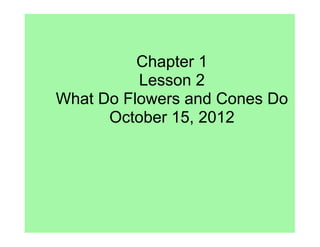
Chapter 1 lesson 2
- 1. Chapter 1 Lesson 2 What Do Flowers and Cones Do October 15, 2012
- 2. 10-15-12 Chapter 1 - Lesson 2 Vocabulary petal pollen pollinate 1. petal - an outside part of a flower that is often colored. 2. pollen - a fine yellowish powder in a flower. 3. pollinate - to carry pollen to the stemlike part of the flower.
- 3. Science Background · Seeds which contain a plant embryo surrounded by a protective seed coat, grow inside flowers. · Flowers are made up of petals and a central pistil (the female part of the flower) that is surrounded by stamens (male flower parts). Pollen grains form on stamen tips (anthers). · During pollination, pollen moves onto the stigma, the sticky tip of the pistil. Pollination allows the mixing of male and female gametes, which is necessary for fertilization to occur. · Plants produced by sexual reproduction inherit genes from both parent plants, are unique, and may have traits that differ from those of parent plants. Asexual plant reproduction occurs through the division of one plant. Plants produced in this way inherit genes from only one parent and have exactly the same traits as the parent plant's. · Plants can reproduce through vegetative propagation using cuttings, tubers, bulbs, and layering. Tubers, such as potatoes, have yes that may sprount new shoots. Bulbs, such as tulips daffodils, onions, and garlic, have lateral, or branch, buds that develop into new bulbs.
- 4. Quick Quiz #1 1. What are petals? Petals are the brightly colored outside parts of a flower. 2. Where are two places you might find pollen in a flower? Two places you might find pollen in a flower are where pollen is made (the stamen) and on the tip of the stemlike part (pistil). 3. How does the center part of a flower change as seeds grow? The center part of a flower changes as it swells to form a fruit around the seeds. H.O.T. Remember any part of a plant that has seeds is a fruit. Therefore, which of the following are fruits and which are vegetables: an apple, a cabbage, a pepper, a tomato, and celery? Vegetables = cabbage, celery. Fruits=apple, pepper, and tomato.
- 5. Science Background · Pollination is the process of transferring pollen from one flower part (the male reproductive part) to another (the female reproductive part). · Animals and wind are two agents of pollination. The color and smell of a flower may attract certain animals with adaptations that allow them to pollinate those flowers. · Cones, like flowers, may form seeds following pollination. Most cone-producing plants are evergreens.
- 6. Quick Quiz #2 1. What effect do a flower's colors and smells have on animals? Animals are attracted to flowers by their colors and smells. 2. What happens when a bee lands on a flower? When a bee lands on a flower, the bee brushes against pollen and the pollen sticks to the bee's body. 3. What are two ways that a flower can be pollinated? Two ways that a flower can be pollinated are by wind and/or by animals scattering the pollen. H.O.T. Some plants depend on specific insects to pollinate them. What might happen if the insects that pollinate a particular type of plant were killed by pesticides? If the insects that pollinate a particular type of plant were killed by pesticides, the plants would no longer form seeds and reproduce.
- 11. The roots the leaves the stem the flower The roots the fruit the seeds absorb water and minerals from the soil make food for the plant. will grow into new plants. contains the seeds. carries water to all plant parts. is where the seeds are formed.
